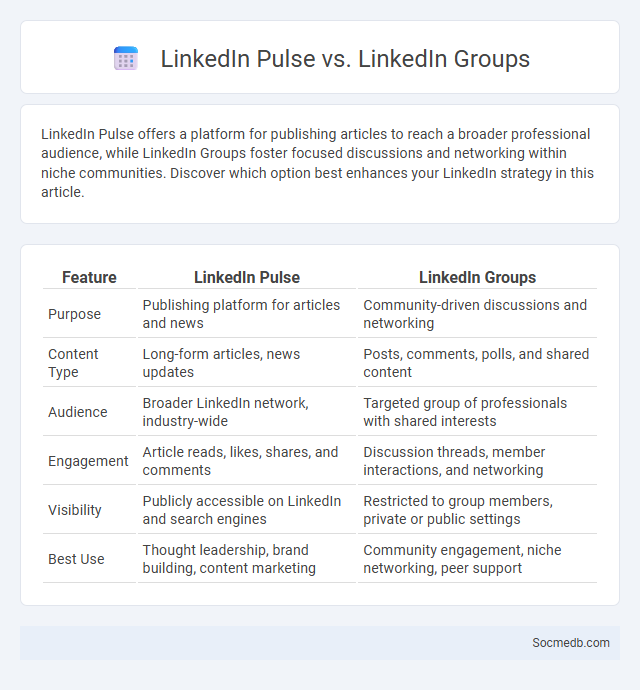
Photo illustration: LinkedIn Pulse vs LinkedIn Groups
LinkedIn Pulse offers a platform for publishing articles to reach a broader professional audience, while LinkedIn Groups foster focused discussions and networking within niche communities. Discover which option best enhances your LinkedIn strategy in this article.
Table of Comparison
| Feature | LinkedIn Pulse | LinkedIn Groups |
|---|---|---|
| Purpose | Publishing platform for articles and news | Community-driven discussions and networking |
| Content Type | Long-form articles, news updates | Posts, comments, polls, and shared content |
| Audience | Broader LinkedIn network, industry-wide | Targeted group of professionals with shared interests |
| Engagement | Article reads, likes, shares, and comments | Discussion threads, member interactions, and networking |
| Visibility | Publicly accessible on LinkedIn and search engines | Restricted to group members, private or public settings |
| Best Use | Thought leadership, brand building, content marketing | Community engagement, niche networking, peer support |
Introduction to LinkedIn Pulse and LinkedIn Groups
LinkedIn Pulse is a content publishing platform that enables professionals to share industry insights, articles, and thought leadership directly with their network. LinkedIn Groups foster community engagement by connecting members with similar professional interests, facilitating discussions, knowledge exchange, and networking opportunities. Together, these features enhance personal branding and industry visibility within the LinkedIn ecosystem.
What is LinkedIn Pulse?
LinkedIn Pulse is a content publishing platform integrated into LinkedIn, enabling professionals to share articles, insights, and industry news directly with their network and a broader audience. It enhances your personal brand by amplifying thought leadership and increasing visibility across relevant professional circles. Leveraging LinkedIn Pulse effectively can boost engagement and establish your expertise in your field.
What are LinkedIn Groups?
LinkedIn Groups are online communities within the LinkedIn platform where professionals with shared interests, industries, or goals can connect, share content, and engage in discussions. These groups facilitate networking, knowledge exchange, and collaboration by allowing members to post articles, ask questions, and participate in topic-specific conversations. With millions of active groups available, LinkedIn Groups serve as valuable resources for industry insights, job opportunities, and professional development.
Pulse: A Deeper Dive
Pulse provides real-time analytics and audience insights by leveraging AI-driven algorithms to track user engagement across multiple social media platforms. Its dynamic dashboard offers granular data on content performance, sentiment analysis, and influencer impact, enabling marketers to tailor strategies effectively. By integrating comprehensive metrics and predictive analytics, Pulse enhances decision-making and optimizes social media campaigns for higher ROI.
Key Features Comparison
Social media platforms vary significantly in key features such as content format, audience engagement tools, and privacy settings. Instagram emphasizes visual storytelling with photo and video sharing, while Twitter focuses on brief, real-time updates and trending topics. Understanding these differences helps you choose the platform that best aligns with your communication goals and user preferences.
Audience Reach and Engagement
Maximizing your audience reach on social media requires targeted content tailored to platform-specific algorithms and user preferences. Enhancing engagement involves using interactive elements such as polls, stories, and personalized responses to foster genuine connections with followers. Consistent analysis of metrics like impressions, click-through rates, and follower growth helps optimize your strategy for sustained social media success.
Content Creation and Sharing
Content creation on social media involves generating engaging posts, videos, and images tailored to target audiences to increase visibility and interaction. Sharing content across platforms like Instagram, TikTok, and Twitter amplifies reach and drives organic growth through user engagement and algorithmic promotion. Effective social media content strategies leverage trends, hashtags, and multimedia formats to maximize audience retention and brand awareness.
Networking Opportunities
Social media platforms like LinkedIn, Twitter, and Facebook provide unparalleled networking opportunities by connecting professionals across diverse industries and geographic locations. These platforms facilitate the exchange of ideas, collaboration on projects, and access to job openings through targeted groups and communities. Strategic engagement on social media enhances visibility, builds relationships, and drives career growth in competitive markets.
SEO and Visibility Differences
Social media platforms influence SEO by driving traffic and increasing brand visibility through shared content and engagement signals. Your active presence on channels like Instagram, LinkedIn, and Twitter enhances search engine rankings by boosting backlink profiles and user interaction metrics. Optimizing social media profiles with relevant keywords and consistent posting improves your digital footprint, differentiating visibility across various search engines.
Choosing the Right Platform for Your Goals
Choosing the right social media platform depends on your specific goals, whether it's brand awareness, lead generation, or customer engagement. Platforms like Instagram and TikTok excel in visual storytelling, making them ideal for brands seeking to connect with younger audiences, while LinkedIn offers powerful tools for B2B networking and professional growth. Your success on social media hinges on selecting the platform that aligns with your target audience and business objectives.
 socmedb.com
socmedb.com